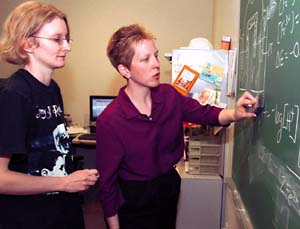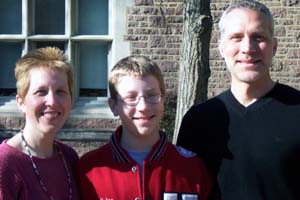Regina Frey is doing exactly what she wants to be doing — working with faculty and teaching students.
“It’s been a wonderful experience so far. I really enjoy what I do,” says Frey, Ph.D., senior lecturer in chemistry and assistant dean in Arts & Sciences and director of the Teaching Center.

Frey is passionate about her duties on campus and divides her time equally between the Teaching Center and chemistry classes.
She was initially hired to help improve the educational aspect of the general chemistry lecture series — to add more of an educational experience for the students. But after being named associate director of the Teaching Center in 2001, she found an immediate outlet for her marketing and people skills.
Besides teaching courses in general chemistry, Frey helped design the Department of Chemistry Web page, www.chemistry.wustl.edu. The site is integral to her courses, as it includes syllabuses, problem sets, quiz solutions and announcements.
One of her goals in designing the site was to include more visualization for the general lecture series to help students grasp the chemical concepts.
“Shape is very important in chemistry,” she says. “For example, for drugs to work, the molecules have to fit perfectly into the active site. Students need to be able to visualize molecules in 3-D to fully understand them. But traditionally molecular diagrams have been shown in 2-D.”
When Frey came to the University, one of her first tasks was to begin designing those 3-D images, many of which are in full color on the chemistry Web site.
Frey’s other mission has been to make chemistry more accessible and relevant to all students.
“In general chemistry, many of the students are in pre-medicine or engineering and aren’t necessarily going to be chemists,” Frey says. “But they need to take chemistry because it’s important to their fields of interest.
“The traditional way chemistry is taught makes it difficult for students to see where they will use chemistry in their future careers.”
With Arts & Sciences collaborators J. Dewey Holten, Ph.D., professor of chemistry, former undergraduate student Rachel Casidy and undergraduate chemistry lab supervisor Michelle Gilbertson, Frey began to work on a series of interdisciplinary Web-based tutorials to show the relevance of chemistry.

“Examples of tutorials include describing the dialysis process in the kidneys or the chemical processes involved in vision,” she says. “The idea is that students will start to see that the concepts they are learning in chemistry class really are important, no matter what field they might eventually enter.”
Joseph J.H. Ackerman, Ph.D., chemistry chair and the William Greenleaf Eliot Professor, says, “The chemistry department considers itself extremely fortunate to have recruited Dr. Frey to the Washington University campus. She has proven to be a stellar instructor and a wise counselor.
“Wisely, Arts & Sciences has sought her contributions in areas extending far beyond the chemical arena. Gina is one of those special individuals who make this University sparkle.”
Frey earned a bachelor of science degree in chemistry and mathematics from Clarion State University. She then went on to earn a doctorate in physical chemistry from the University of Utah in 1986.
After doing postdoctoral work in chemistry, Frey worked in IBM’s marketing division.
She came to the University in 1994, and in 2002 she succeeded James W. Davis, Ph.D., professor of political science in Arts & Sciences, as director of the Teaching Center.
When she isn’t teaching chemistry, Frey can be found at the center, busily making sure everything is running smoothly.
The Teaching Center has several missions, but a primary one is to enhance and improve teaching at the University. That is accomplished through consultation with professors, faculty workshops and department-specific teaching assistant workshops.
Frey has a hand in all three.
“At a professor’s request, I visit or tape a professor’s class and then consult with the professor about improvements in their teaching,” Frey says. “Faculty members often come to the Teaching Center to discuss teaching methods or how to better structure their classes.
“I also work with graduate students, not only for their teaching here, but to better prepare them for going out into the job market.”
The other major portion of the work at the Teaching Center involves managing and improving the University’s classrooms.
Regina Frey, Ph.D.University title: Senior lecturer in chemistry and assistant dean in Arts & Sciences and director of the Teaching CenterHobbies: Cooking, reading and runningYears at the University: 9″The great thing about what I’m doing is that I get to interact with people from all of the schools at the University,” Frey says. “It’s amazing how my teaching has grown and improved just by listening to what other faculty members want to do in their classes.””While we have done a wonderful job of implementing technology in the classrooms, we are starting to focus more on the design of the classrooms themselves,” Frey says.
Along with her staff, Frey began looking at ways to take the box that is a classroom and make it better.
“And making it better includes more than just adding technology,” she says. “Improvements include the layout of the furniture, the type of furniture, the lighting, placement of chalkboards, where light switches are, etc.
“Our goal, starting this year, is to get in near the front of the design process for our new classroom buildings so that we work with the faculty and architects to design the best classrooms for students and teachers.”
The challenge, Frey said, is how to design the room so that the students learn better and the teacher can best present and interact with the students.
“It’s a pleasure taking my experience as a teacher and turning that knowledge into something that can benefit both students and professors,” she says.
Frey particularly enjoys talking with faculty members about their classrooms and their jobs.
“The great thing about what I’m doing is that I get to interact with people from all of the schools at the University,” she says. “It’s amazing how my teaching has grown and improved just by listening to what other faculty members want to do in their classes.
“What occurs in a typical science class is not the same as what occurs in a humanities class. It’s wonderful to incorporate ideas from other professors into my own teaching.”
“Gina Frey is a dynamo, a continuing example of enthusiastic, energetic multitasking,” Davis says. “Advising a student one minute, planning a faculty workshop the next, teaching her own chemistry class or working on a classroom upgrade — Gina sets an example for us all.
“I cannot imagine anyone who would be a better or more appropriate director of the Washington University Teaching Center. She is a delight to work with.”
Frey is married to William E. Buhro, Ph.D., professor of chemistry. They met at the University of Utah and married after she earned her doctorate. The couple’s son, Walter, is 12.
“Walter is a dedicated football player,” Frey says. “He joined a junior football league, so in the fall the entire family is quite involved with that.
“He needed to get in shape for football, so Walter and I started running together. We’ve run several short races together. I actually took fourth place in my age group in the Frostbite Series this winter. It’s been a great experience for me because it keeps Walter and me close.”
Frey enjoys working at the University. She says support and mentoring have come from many people, including Ackerman, James E. McLeod, vice chancellor for students and dean of the College of Arts & Sciences, and Edward S. Macias, Ph.D., executive vice chancellor and dean of Arts & Sciences.
“I’ve had such great support from people here,” she says. “I’m the type of person who likes to try different ideas, and this administration has been very open and willing to let me test all types of ideas. Not every place lets you do that.”
The students have also made a great impression on her.
“I feel very fortunate and very honored to be able to teach our students,” she says. “They are great students and great kids. The nice part is, I get them as they enter college. There are all these changes going on and they are just full of spirit and hope, and I feel very privileged that I can spend that first semester being with them and helping them become a part of this University. I really couldn’t ask for anything more.”